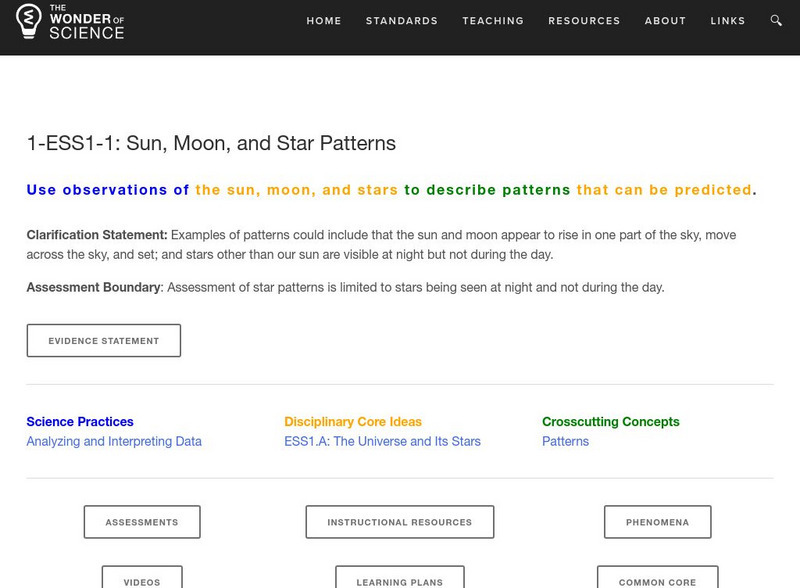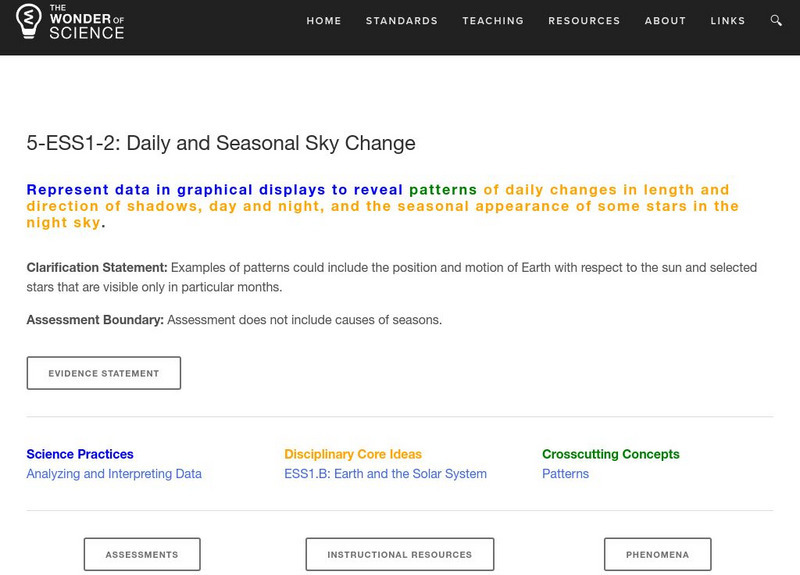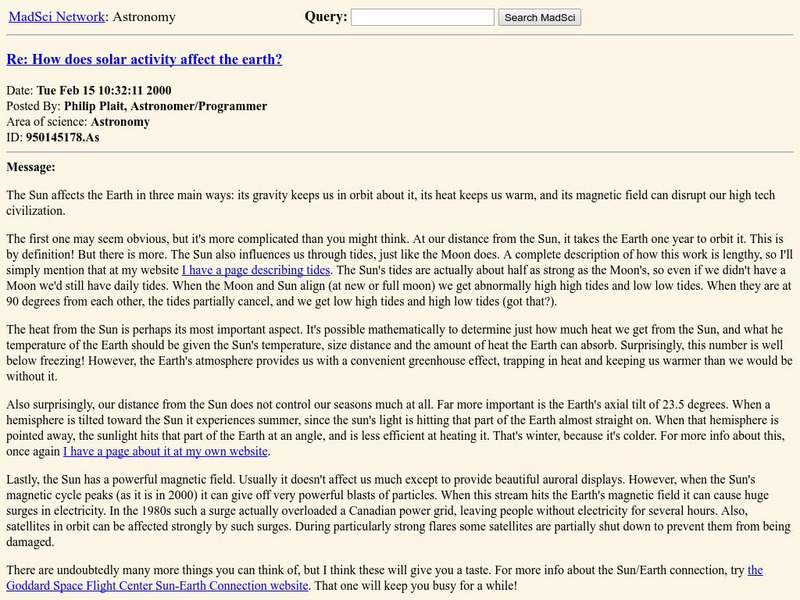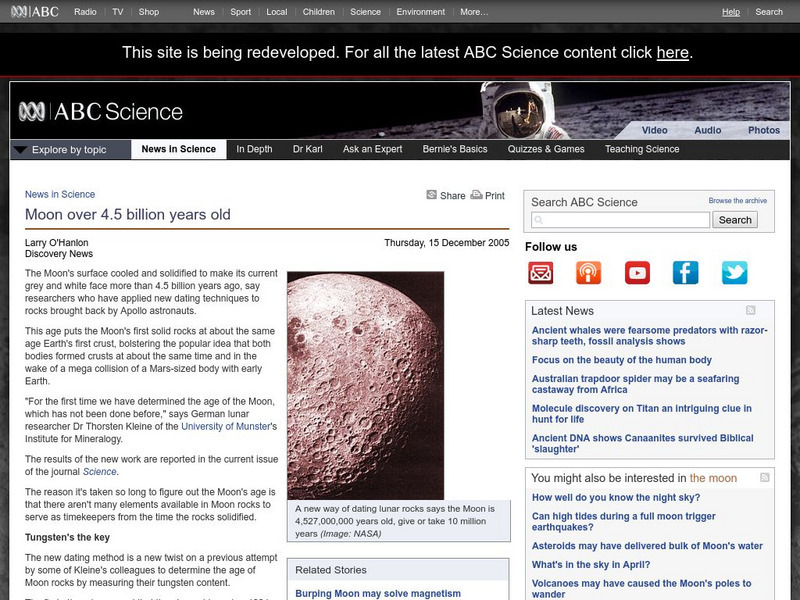The Wonder of Science
The Wonder of Science: 1 Ess1 1: Sun, Moon, and Star Patterns
The NSTA vetted source includes resources to help students describe patterns of the sun, moon, and stars using observation. Included are assessment ideas, videos, examples, lesson plans, and photos of student work.
The Wonder of Science
The Wonder of Science: 5 Ess1 2: Daily and Seasonal Sky Change
Work samples, phenomena, assessment templates, and videos that directly address standard 5-ESS1-2: daily and seasonal sky change.
NC State University
Ncsu.edu: Adventures of the Agronauts
This site is an online science curriculum on how to grow plants on the Moon. There are six lessons that have a glossary also included. There are movies that demonstrate concepts, and teacher resources. The sites topics cover, the Earth,...
NC State University
Adventures of the Agronauts
Come along with the Agronauts and discover space in order to report back to Commander Spud Goodroot. Fun site provides all types of information about space science! Various missions include: 'What's In Our Sky?', 'The Root of the...
Project Britain
Primary Homework Help: Earth and Space Quiz
This resource provides information about Earth and space. In addition, there is a quiz provided.
TED Talks
Ted: Ted Ed: A Rare, Spectacular Total Eclipse of the Sun
Andy Cohen details the extraordinary celestial phenomenon of a total solar eclipse, and when it will next occur. [3:47]
PBS
Pbs Learning Media: Nova: The Origin of the Moon
This video segment [3:56] adapted from NOVA follows the Apollo 15 astronauts as they collect samples of ancient rock from the Moon's crust, whose discovery helps lead to a radical new theory about the Moon's origin.
Utah State Office of Education
Utah Science: How Are Earth and Its Moon Alike?
Participate in the experiments offered by Utah Science and discover the similarities between the Earth and its moon.
Cool Math
Coolmath: Science Monster: Our Moon
Read about our planet's only satellite, better known as the moon in this colorful, illustrated tutorial.
BBC
Bb Ci Space: Earth
The BBC provides a general overview of the planet Earth. Content includes statistical information, a focus on the four seasons, moon information, and more.
Alabama Learning Exchange
Alex: Moon Phases
This lesson plan will familiarize middle schoolers with the phases of the moon. It can be taught in a unit dealing with the solar system. It involves all learning types-kinesthetic, auditory, tactile, and visual.
Alabama Learning Exchange
Alex: Moon Phase Craze
This lesson plan is designed to use online technology resources to practice and reinforce knowledge learned in class on Moon Phases. Students will view online animations with student interaction, while keeping a log of their phase...
Alabama Learning Exchange
Alex: The Moon's Craters
This instructional activity will help students understand impact craters and infer how they were formed and the reason for their differences in size.
Alabama Learning Exchange
Alex: Phases of the Moon
This lesson will familiarize students with the phases of the moon. It can be taught in a unit dealing with the solar system. It involves all learning types-kinesthetic, auditory, tactile, and visual.
CK-12 Foundation
Ck 12: First Grade Science
This customizable digital textbook covers topics related to first-grade science. It is Next Generation Science Standards (NGSS) aligned.
CK-12 Foundation
Ck 12: Earth Science: Moon Study Guide
A general overview and review guide of the moon.
PBS
Pbs Learning Media: The Pattern of the Moon's Changing Appearance
Students use an interactive model to gather evidence about the visible Moon's changing pattern over 30 days in this resource from Astronomy Education at the University of Nebraska-Lincoln. They use this evidence to record and make...
PBS
Pbs Learning Media: Different Appearances of the Moon
The digital slideshow provides students with the opportunity to observe and use evidence from their observations to predict and record how the Moon appears to follow a regular pattern of change over time. Teaching tips and background...
Louisiana Department of Education
Louisiana Doe: Louisiana Believes: Ela Unit: Grade 1: Mooncake
First graders learn factual information about the moon and how light creates shadows. Noting that authors oftentimes use their imaginations to create stories, 1st graders explore how misconceptions and misunderstandings can often be...
Cornell University
Cornell University: Astronomy: Eclipses
This site from the Astronomy Department of Cornell University provides brief introduction to both solar and lunar eclipses. Links are provided for pictures and charts of the eclipses, and this is a good site to check out on the subject.
MadSci Network
Mad Scientist: Why High Tide Away From the Moon or Sun?
An excellent and thorough answer to the often asked question about high tide "bulges" on the side of Earth facing away from the Moon or Sun.
Exploratorium
Exploratorium: Third From the Sun
This site offers a short history of the evolution of the space program and man's quest for more revealing and detailed pictures of the earth.
Australian Broadcasting Corporation
Australian Broadcasting Corporation: News in Science: Moon Over 4.5 Billion Years Old
From ABC News in Science, Larry O'Hanlon's article uses research connected to the element tungsten-182 found on the Moon to develop theories as to the age of the Moon and the formation of the Moon.
NASA
Nasa: Jupiter: Moons: Elara
Statistics and general information about the thirteenth moon of Jupiter. One statement sums it up: "Very little is known about Elara."
















